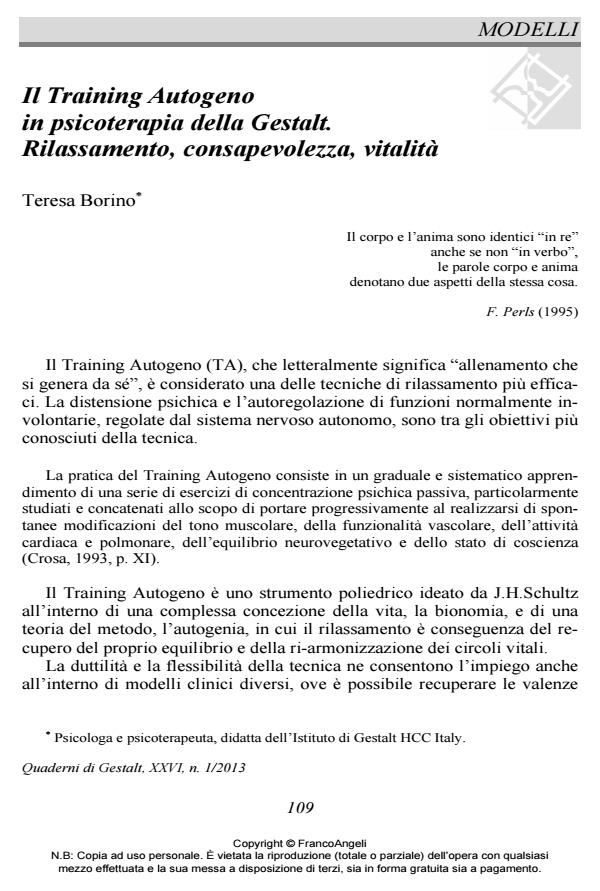The Autogenic Training in Gestalt Therapy. Relaxation, awareness, vitality
Journal title QUADERNI DI GESTALT
Author/s Teresa Borino
Publishing Year 2013 Issue 2013/1
Language Italian Pages 15 P. 109-123 File size 1138 KB
DOI 10.3280/GEST2013-001009
DOI is like a bar code for intellectual property: to have more infomation
click here
Below, you can see the article first page
If you want to buy this article in PDF format, you can do it, following the instructions to buy download credits

FrancoAngeli is member of Publishers International Linking Association, Inc (PILA), a not-for-profit association which run the CrossRef service enabling links to and from online scholarly content.
The hereby article proposes a characterization about the learning and the Autogenic Training use within the frame of the theorical-methodologic of the Gestalt Therapy. It shows in which way this adoption can give benefits not only in acquiring major awareness of the body and consequently psychophysical relax, but also it works as a support for a path of availability to open oneself to the change in the organism/environment contact, in order to the therapeutic change. The A.T. use is helpful to the therapist as well, to keep his own ability in feeling his own body while training.
Keywords: Autogenic Training, Gestalt Therapy, autogeny, spontaneity, self-regulation, body.
- Perls F. (1980). La terapia gestaltica. Parola per parola. Roma: Astrolabio.
- Perls F.S., Hefferline R.F., Goodman P. (1997). Teoria e pratica della Terapia della Gestalt. Vitalità e accrescimento nella personalità umana. Roma: Astrolabio.
- Crosa G. (1993). Presentazione dell’opera di J.H. Schultz. In: Schultz J.H. Il training autogeno. Voll. 1-2, XI-XVI. Milano: Feltrinelli Damasio A. (2000). Emozione e coscienza. Milano: Adelphi.
- Have de Labije J. (2008). Quando l’ansia del paziente è in primo piano. In: Psyche Nuova. Padova: Cisspat.
- Hoffmann B. H. (1980). Manuale di Training autogeno. Roma: Astrolabio.
- Kepner J.I. (1997). Body Process. Il lavoro con il corpo in psicoterapia. Milano: FrancoAngeli.
- Onfray M. (2006). Teoria del corpo amoroso. Roma: Fazi Editore.
- Peresson L.(1990). Psicoterapia autogena. Padova: Cisspat.
- Perls F. (1995). L’Io, la fame, l’aggressività. Milano: FrancoAngeli.
- Salonia G. (2008). La Gestalt Therapy e il lavoro sul corpo. Per una rilettura del fitness. In: Vero S. Il corpo disabitato. Semiologia, fenomenologia e psicopatologia del fitness. Milano: FrancoAngeli.
- Schultz J.H. (1993). Il Training autogeno. Voll. 1 e 2. Milano: Feltrinelli.
- Schultz J.H. (2001). Psicoterapia bionomica. Un esperimento fondamentale. Milano: Masson.
- Selye H. (1957). Stress. Torino: Einaudi.
- Spagnuolo Lobb M. (2011a). Il now-for-next in psicoterapia. La psicoterapia della Gestalt raccontata nella società post-moderna. Milano: FrancoAngeli.
- Spagnuolo Lobb M. (2011b). Il now-for-next tra neuroscienze e psicoterapia della Gestalt. Dialogo tra Vittorio Gallese e Margherita Spagnuolo Lobb. Quaderni di Gestalt, XXIV, 2: 11-26. DOI: 10.3280/GEST2011-002002
- Esperimento: estetica e reciprocità nella clinica contemporanea Luca Pino, in QUADERNI DI GESTALT 1/2021 pp.109
DOI: 10.3280/GEST2021-001012 - La spiritualità incarnata in psicoterapia della Gestalt Silvia Alaimo, in QUADERNI DI GESTALT 1/2018 pp.59
DOI: 10.3280/GEST2018-001005 - Le ‘maintenant-pour-l’ensuite’ Margherita Spagnuolo Lobb, Joseph Caccamo, in Cahiers de Gestalt-thérapie /2018 pp.58
DOI: 10.3917/cges.039.0058
Teresa Borino, Il Training Autogeno in psicoterapia della Gestalt. Rilassamento, consapevolezza, vitalità in "QUADERNI DI GESTALT" 1/2013, pp 109-123, DOI: 10.3280/GEST2013-001009